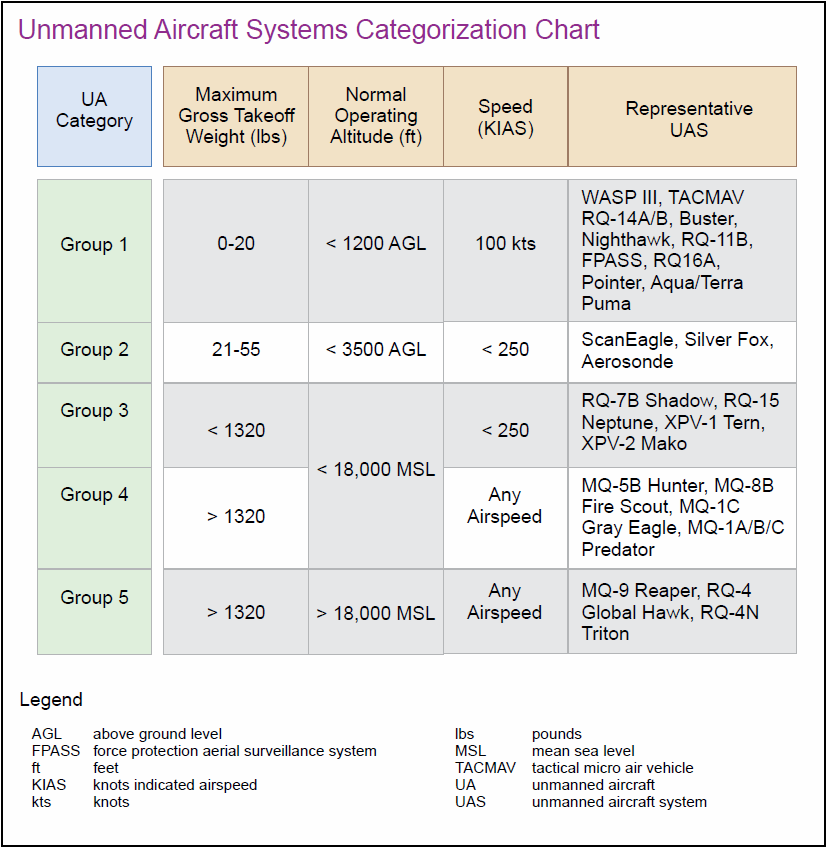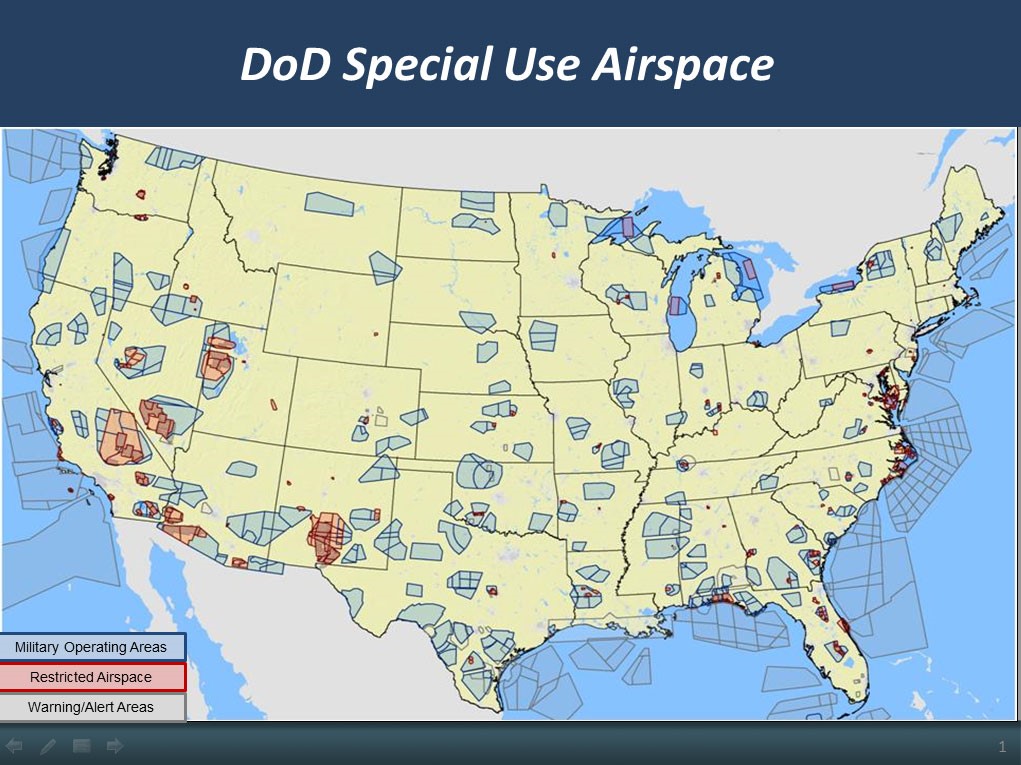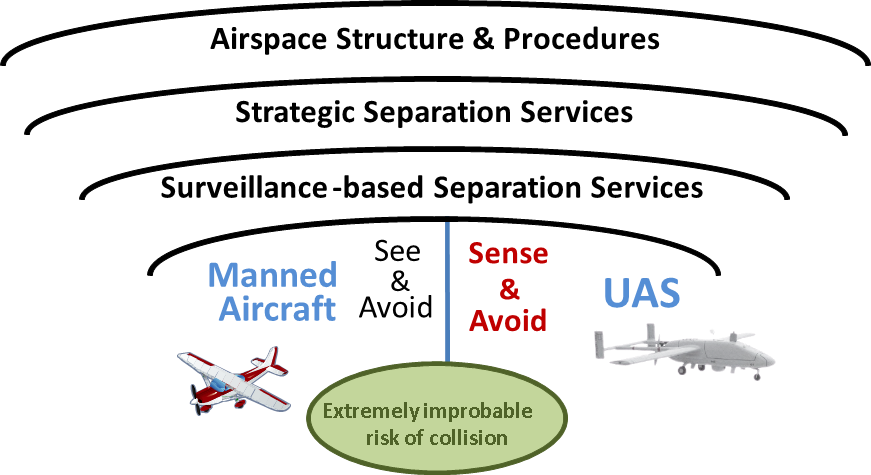Section 3. Large UAS (MGOW 55 Pounds or More)
-
Large Public UAS Operations
- Large public UAS may have wingspans as large as commercial airliners, and may operate in and out of public/military dual-use airfields. Due to the high altitudes at which these UAS routinely operate, and the means through which they reach and vacate operating altitudes, encounters with manned or low-altitude unmanned traffic are rare.
-
Public users operating as “public aircraft” retain the responsibility to determine airworthiness and pilot qualifications. Aircraft certification and operating rules apply to the entire UAS, including the aircraft itself, the flight crew with their associated qualifications, the control station, and command and control links.
NOTE-
Large UAS operating in controlled airspace generally communicate on radio frequencies or through an ATC-to-PIC ground communications link assigned to that sector, terminal area, or control tower. The UAS PIC is required to comply with all ATC instructions and uses standard phraseology per FAA Order JO 7110.65, Air Traffic Control, and this manual.
REFERENCE-
49 USC 40102, Definitions.
49 USC 40125, Qualifications for Public Aircraft Status.
FAA Order JO 7110.65, Air Traffic Control.
AIM, Para 11-4-3, Airspace Access for Public Aircraft Operations PAO. -
Operating characteristics of large public UAS. To illustrate the sizes and performance of large public UAS, consider the DoD UAS classification system. The categories (see FIG 11-3-1) are separated based on MGOW, normal operating altitude, and flying speed. These classifications do not apply to non-DoD civil aircraft. Generally, Groups 1 through 3 UAS will operate on and above military bases, in restricted or prohibited airspace. For this reason, these smaller tactical public aircraft will rarely be encountered by civil pilots. Groups 4 and 5 are the largest of DoD UAS, weighing over 1,320 pounds, and operating at all speeds and altitudes. Group 4 aircraft operate at all altitudes, usually below 18,000 feet MSL. Group 5 aircraft typically operate well above 18,000 feet MSL. UAS in Groups 4 and 5 require airfields with specially approved surfaces to safely operate. For specifications and descriptions of the aircraft models that the DoD operates, refer to military service fact sheets.
NOTE-
- The category chart does not specify the actual high gross weights at which some DoD UAS actually operate. For instance, the RQ-4 Global Hawk regularly operates at approximately 32,000 pounds.)
- JP 3-30, III 31, Joint Publication 3-30, provides the UAS Categorization Chart and may be reviewed at:
https://www.jcs.mil/Portals/36/Documents/Doctrine/pubs/jp3_30.pdf?ver=2019-09-04-142255-657. - These websites provide unclassified descriptions, performance, and specifications of the varied UAS in the DoD's large category fleet:
USAF Fact Sheets at https://www.af.mil/About-Us/Fact-Sheets/ and USN Fact Files at https://www.navy.mil/Resources/Fact-Files/.
FIG 11-3-1
DoD UAS Categories
-
Large Public UAS Engineering Characteristics and Operating Areas:
- Large public UAS may be sharing airspace with civil aircraft in the NAS. A wide variety of aircraft performance, voice radio communications, command and control link architecture, and operating procedures exists throughout the DoD and other large public UAS enterprises. For example, Group 4 DoD aircraft, such as the MQ-1 Predator and MQ-9 Reaper, are typically propeller-driven with propulsion units that are internal combustion piston- or turbine-powered. The largest public UAS include single-engine jet aircraft such as the RQ-4 Global Hawk and MQ-4C Triton.
- VLOS and BVLOS link systems provide command and control for these large UAS operations. Voice communication capability in the largest public UAS is far more extensive than in the smaller aircraft. Many models are limited to a single voice radio transmitter and receiver system for control inside airspace managed by and/or delegated to the DoD.
-
Many of the larger public UAS are equipped with transponders to assist ATC with position and tracking information. These UAS usually operate under IFR under positive ATC control and will tend to be found at very high altitudes; not likely to be encountered by civil aircraft operators. Launch and recovery operations will be likewise under positive ATC control and these UAS will be separated from any other known aircraft traffic. Encounters with low-altitude small UAS, being flown in uncontrolled airspace or under low-altitude controlled airspace authorizations, are therefore unlikely. In accordance with 14 CFR section 91.215(e)(2), ATC Transponder and Altitude Reporting Equipment and Use, no person may operate an unmanned aircraft under part 91 with a transponder on unless: (1) the operation is conducted under a flight plan and the person operating the unmanned aircraft maintains two-way communications with ATC; or (2) the use of a transponder is otherwise authorized by the Administrator.
NOTE-
In accordance with 14 CFR section 107.52, ATC Transponder Equipment Prohibition, unless otherwise authorized by the Administrator, no person may operate a sUAS under part 107 with a transponder on.
REFERENCE-
14 CFR Section 91.215, ATC Transponder and Altitude Reporting Equipment and Use.
14 CFR Section 107.52, ATC Transponder Equipment Prohibition.
-
Large Public UAS Launch, Recovery, and Operating Areas:
-
Large public UAS operations are widespread, they are also carefully managed to ensure enhanced safety for other NAS users. For this reason, DoD UAS operate in many types of special use airspace. See FIG 11-3-2 for examples of Special Use Airspace (SUA) used by DoD UAS.
FIG 11-3-2
DoD Special Use Airspace
- Temporary Flight Restrictions (TFRs) are issued for the surrounding UAS operating locations and allow for the launch and recovery of larger UAS. Once outside of the terminal environment, DoD UAS utilize the full range of SUA, including Military Operating Areas (MOA), restricted areas, warning areas, and alert areas to conduct their missions.
-
Large public UAS operations are widespread, they are also carefully managed to ensure enhanced safety for other NAS users. For this reason, DoD UAS operate in many types of special use airspace. See FIG 11-3-2 for examples of Special Use Airspace (SUA) used by DoD UAS.
-
Exemptions Under 49 USC 44807, Special Authority for Certain Unmanned Systems
-
Exemptions are granted to UAS operations which are permitted in accordance with Public Law 115-254, 49 USC 44807, Special Authority for Certain Unmanned Aircraft Systems. The Secretary of Transportation has determined that certain UAS are eligible to operate in the NAS without possessing the airworthiness certification normally required under 49 USC 44807. 49 USC 44807 permits the FAA to use a risk-based approach to determine whether an airworthiness certificate is required for a UAS to operate. Exemptions are generally requested by civil (non-public) UAS operators who fly UAS weighing 55 pounds or more, and thus cannot fly under 14 CFR part 107. For civil UAS operations conducted under 49 USC 44807 of PL 115-254, the Secretary has determined that specific requirements necessary for safe operation can often be addressed in the form of grants of exemption(s). Operators who desire this regulatory relief must petition the FAA for exemption in accordance with 14 CFR part 11 and the guidance provided on the FAA's Section 44807, Special Authority for Certain Unmanned Systems website. Examples of petitions that have been granted to conduct civil UAS operations include the following activities:
- Closed-set motion picture and television filming.
- Agricultural survey and spraying.
- Aerial photography.
- Land survey and inspection.
- Inspection of structures.
-
Search and Rescue (SAR) operations.
NOTE-
Civil agricultural spraying operations will also require a 14 CFR part 137 certificate; see paragraph 11-4-5, Airspace Access for 14 CFR part 135 and 14 CFR part 137.
-
Exemption Application. Petitioners seeking a grant of exemption should fill out an online application on the public docket located on the FAA's regulations.gov website.
REFERENCE-
49 USC 44807, Special Authority for Certain Unmanned Aircraft Systems.
NOTE-
The FAA's Section 44807: Special Authority for Certain Unmanned Systems website may be reviewed at: https://www.faa.gov/uas/advanced_operations/certification/section_44807/. The FAA's Regulations.gov website may be reviewed at: https://www.faa.gov/regulations_policies/faa_regulations.
-
Exemptions are granted to UAS operations which are permitted in accordance with Public Law 115-254, 49 USC 44807, Special Authority for Certain Unmanned Aircraft Systems. The Secretary of Transportation has determined that certain UAS are eligible to operate in the NAS without possessing the airworthiness certification normally required under 49 USC 44807. 49 USC 44807 permits the FAA to use a risk-based approach to determine whether an airworthiness certificate is required for a UAS to operate. Exemptions are generally requested by civil (non-public) UAS operators who fly UAS weighing 55 pounds or more, and thus cannot fly under 14 CFR part 107. For civil UAS operations conducted under 49 USC 44807 of PL 115-254, the Secretary has determined that specific requirements necessary for safe operation can often be addressed in the form of grants of exemption(s). Operators who desire this regulatory relief must petition the FAA for exemption in accordance with 14 CFR part 11 and the guidance provided on the FAA's Section 44807, Special Authority for Certain Unmanned Systems website. Examples of petitions that have been granted to conduct civil UAS operations include the following activities:
-
Emerging Large UAS Civil Operations
-
Large civil UAS operations in the NAS are presently considered those UAS weighing 55 pounds or more with or without aircraft airworthiness certification, along with their control stations and radio links operating under 14 CFR part 91. These operations may or may not receive ATC separation services, but will not be operating under UAS Traffic Management (UTM) structures. Examples of current large UAS civil operators include agricultural spraying and operation as radio/telephone airborne relays. Future large UAS operations will include carriage of cargo and passengers, and very long- endurance aircraft, staying aloft for extended periods of time.
NOTE-
Large is only used as a term to differentiate from those UAS weighing less than 55 pounds. Large UAS is not an FAA- recognized category of aircraft.
- Large UAS must meet performance, equipage requirements, and adhere to relevant procedures commensurate with the airspace in which the UAS is operating.
- Absent an onboard pilot, large UAS are unable to “see and avoid” other aircraft, as required by regulations governing the general operation of aircraft in the NAS under Title 14 CFR section 91.111, Operating Near other Aircraft, and 14 CFR section 91.113, Right of Way Rules: Except Water Operations. As a result, they cannot use visual observation to remain “well clear” of other aircraft and avoid collisions. Therefore, an alternate means of compliance is required to remain well clear of other aircraft and surface obstacles, and avoid collisions.
-
FIG 11-3-3, A Layered Approach for Collision Avoidance, illustrates the different layers used to keep aircraft safely separated, beginning with airspace classification and design, then ending with the responsibility of the pilot to prevent collisions.
FIG 11-3-3
A Layered Approach for Collision Avoidance
-
Transition to full integration into the NAS. Over time, full integration of large UAS operations in the NAS will be achieved. Current large UAS operations will continue to be dependent on COAs, the issuance of NOTAMs, and possibly other measures (e.g., chase plane, segregated airspace) as currently used for accommodated operations. This integration is evolving with UAS technology advances, FAA regulatory changes, NAS automation, communications improvements, and evolving use cases and demand.
NOTE-
Transponder equipped UAS, during lost link events, if capable, will squawk secondary surveillance radar (SSR)/Transponder code 7400. If the UAS is not programmed for use of SSR code 7400, then code 7600 may be used.
- Large Civil Operations. The following are examples of test and evaluation operations being conducted with large civil and commercial UAS: cargo delivery, infrastructure inspection, surveillance, firefighting, environmental observation, signal relay, and atmospheric sampling.
-
Large civil UAS operations in the NAS are presently considered those UAS weighing 55 pounds or more with or without aircraft airworthiness certification, along with their control stations and radio links operating under 14 CFR part 91. These operations may or may not receive ATC separation services, but will not be operating under UAS Traffic Management (UTM) structures. Examples of current large UAS civil operators include agricultural spraying and operation as radio/telephone airborne relays. Future large UAS operations will include carriage of cargo and passengers, and very long- endurance aircraft, staying aloft for extended periods of time.

